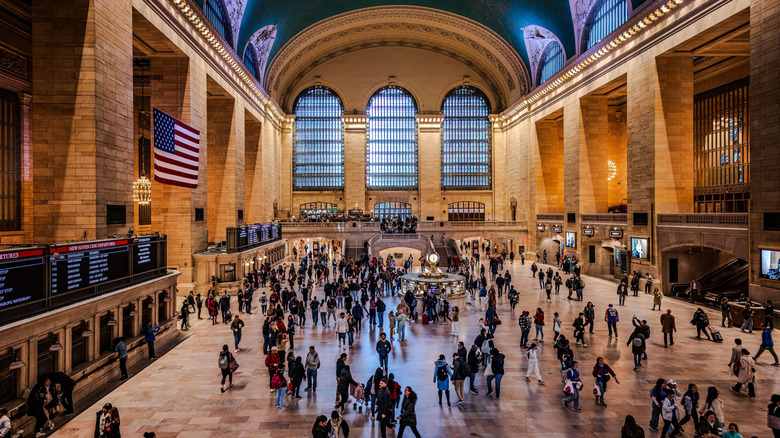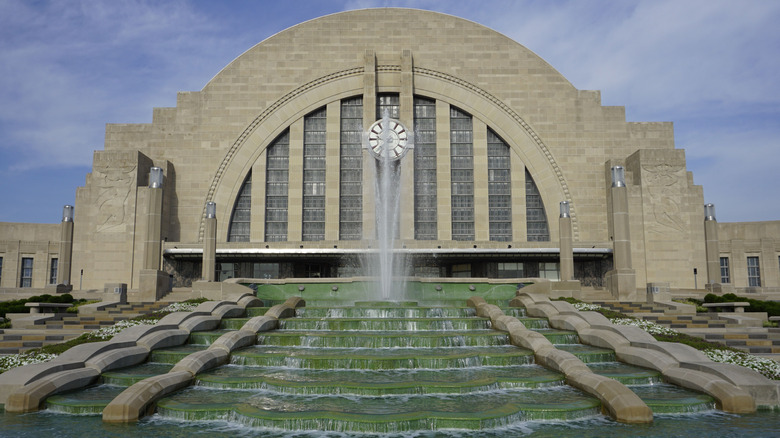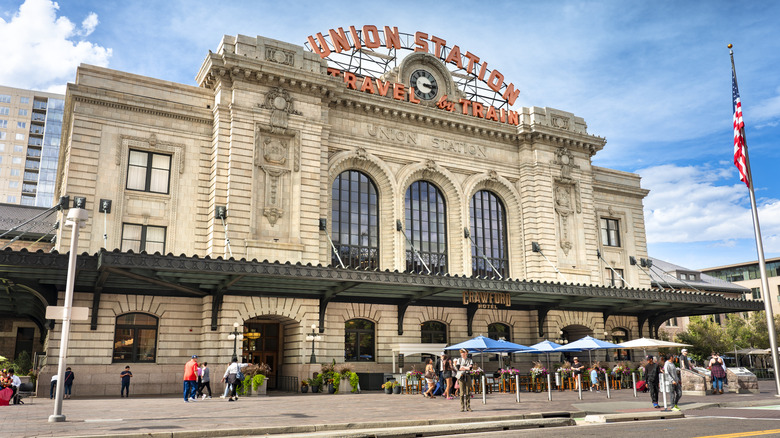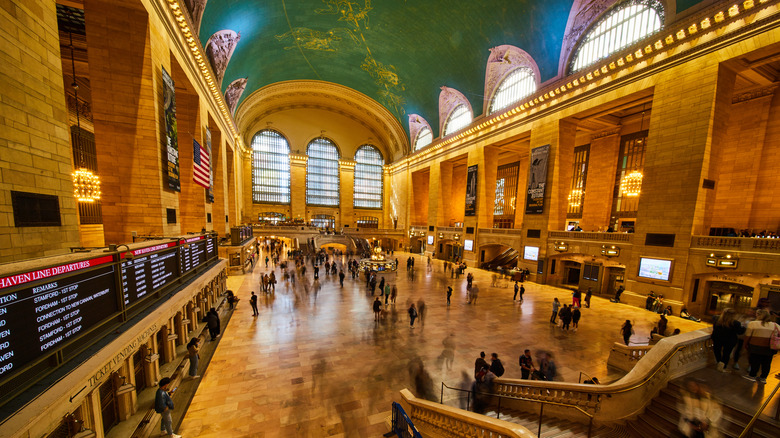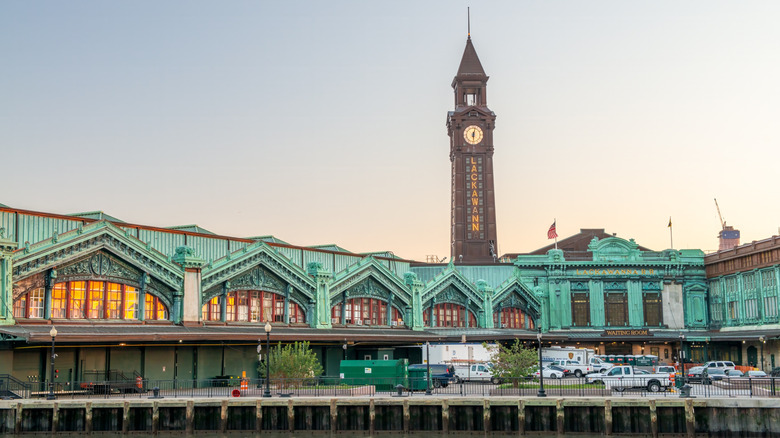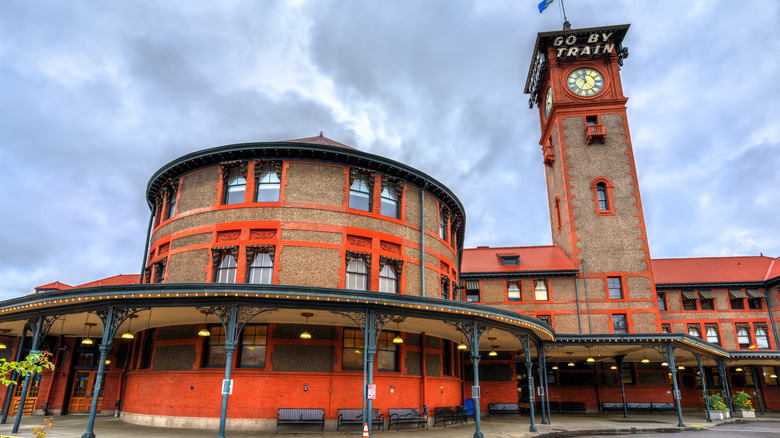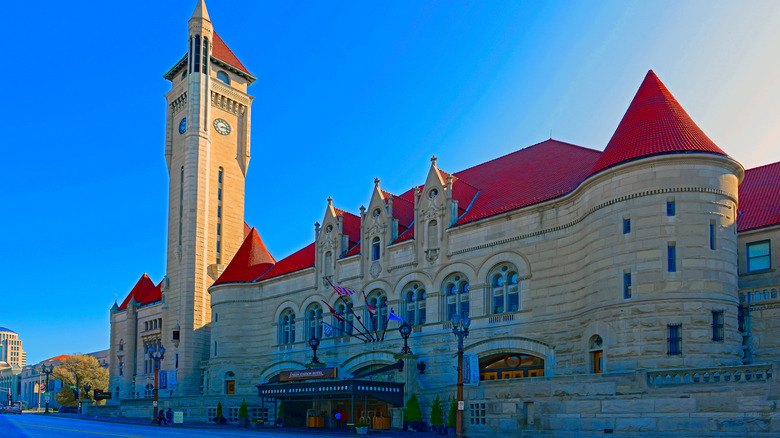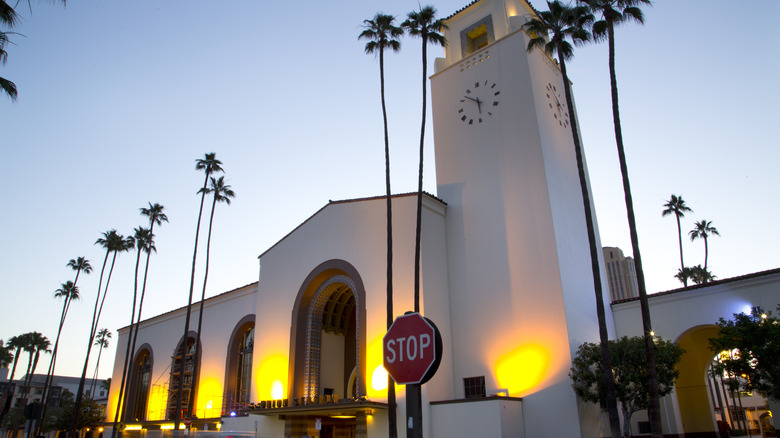The Most Beautiful Train Stations In America Are Destinations In Their Own Right, According To Rail Fans
Much has been made of the decline of American rail travel. Once the go-to method of long-distance domestic travel, it's been on the decline for decades: Passenger rail traffic at some stations across the country declined 84% between 1945 and 1964, as car ownership soared. Car-centric urban planning and the advent of more convenient air travel all dealt significant blows to the viability of American railways.
Even so, much of the infrastructure that served America's rail travelers has survived, and with enough wandering, you'll likely stumble upon an ornate historic train station in most U.S. cities. Some of these train stations are worth the trip just for their stunning architecture. Others have been repurposed as cities seek to breathe new life into old infrastructure, serving diners, lodgers, or museum-goers instead of train passengers. And nearly all have something to offer visitors.
To create this list, we pored over reviews from travelers, architecture lovers, and rail fans on Google Maps, TripAdvisor, and other platforms to get a sense of what stations were most appealing to the largest number of people. Keeping aesthetic appeal in mind, we also examined how these stations are being used today (beyond just serving as transit hubs). To learn more about how we settled on these stations, head to the end of the article. For now, enjoy the grandeur of America's romantic railway past.
Cincinnati Union Terminal
By the close of the 1920s, most of the great big-city train stations had already been serving passengers for years. Cincinnati Union Terminal was a latecomer to that scene in 1933 — but if anything, it's even more spectacular than many of its predecessors. With the largest half-dome ceiling in the Western Hemisphere, and a sleek Art Deco facade you can't miss, it would be worth visiting to gawk at the rotunda alone. But that's not all there is to this formerly bustling train terminal.
Although Union Terminal is still an operational Amtrak station, it's no longer the hub that it once was, so planners had to get creative to ensure this stunning structure would have a place in the city's future. Their solution was to establish the Cincinnati Museum Center within its walls, helping make the structure one of Cincinnati's top-rated attractions.
Even if you're not traveling by train, there's a pretty good chance you'll wind up here. The Cincinnati Museum Center, the Cincinnati Museum of Natural History, and the Cincinnati History Museum draw visitors to the city who may not even know they're visiting a train station. That said, the building itself remains the highlight. In the words of one TripAdvisor reviewer, the exhibits (which include a life-sized replica of a limestone cave) are lovely, but "the highlight is the building itself."
Denver Union Station
Some train stations look to museums and galleries to attract visitors who aren't riding the rails. This one turns its eye to fine dining. Although the landmark Beaux Arts-style Denver Union Station still operates as a stop on the California Zephyr Amtrak line, it expanded its ventures to include some of Denver's best-regarded dining and a luxury hotel. "It's a place where architecture, community, convenience, and hospitality come together," according to one individual on TripAdvisor.
Though a train station has existed on this spot since 1881, the current structure dates to 1914 and was refurbished in 2014. A Beaux-Arts facade and surprising modernist touches in its interior and on its platforms make Denver's train hub one of the most visually striking you'll find. Its iconic neon-lit red sign says it all: It might appear imposing from the front entrance, but its late-in-life refurbishments have given it an approachable lightness that contrasts with the heavier grandeur of your average 20th-century transportation hub.
But striking architecture is no longer the primary draw of this station — not since its 2014 refurbishment. These days, its upper floors host the high-end Crawford Hotel, where you can stay above the station in posh, retro-modern style. The chance for visitors to have a unique culinary experience here constitutes another major station draw. From beloved fine-dining stops Ultreia and Mercantile to the stylish Terminal Bar, Denver Union Station is a reliable place to find just about any dining experience you're looking for.
Grand Central Terminal
There aren't many train stations with nationwide name recognition. In fact, there might only be one — and if that's the case, it's New York City's Grand Central Terminal. Since 1913, it's been a central hub of train traffic in the transit capital of the U.S. You could definitely argue that it's worth a visit just to say you've seen what one reviewer on TripAdvisor called "the most beautiful building in New York."
And with its iconic green vaulted ceilings and high windows, the dramatic Beaux-Arts main hall is instantly recognizable. You could easily justify a visit to simply wander around slack-jawed in a vibrant space that stands out on any list of stations that are past their prime. You can even take a guided tour to learn the building's secrets. But that isn't the only reason to visit.
As a thriving hub for several rail and subway lines, it pays for Grand Central Terminal to offer amenities — and indeed it does. Food options are nearly endless, and it's a surprisingly good place to shop. It features, of all things, a secret tennis club; and the elegant Grand Brasserie is perhaps the closest you'll get to a refined Parisian café this side of the Atlantic. And there's Grand Central Oyster Bar, the station's oldest and most esteemed restaurant — book your table in advance if you're feeling like seafood.
Hoboken Lackawanna Terminal
We've come to an exception to the rule that America's most beautiful train stations are sprawling big-city hubs. Located along the New Jersey waterfront in the New York City metropolitan area, the Hoboken Lackawanna Terminal serves not huge, cross-country train services, but ferries and commuter rail to nearby cities. And though it's the sixth-busiest station in the New York area, it's nowhere near the scale of a Grand Central Terminal, nor was it ever meant to be. But that doesn't stop it from making list after list of the most beautiful train stations in the U.S. Why? Thank its waterfront facade for that.
There are plenty of Beaux-Arts train stations around, but this one's stately copper facade is especially striking set against the bustling Hudson River waterfront. Workaday as its function may be, it offers the impression of a much grander terminal with its stylistic ostentation and iconic clock tower. It was innovative for its time, too: When it was constructed in 1907, Hoboken Lackawanna Terminal was unusual for allowing multiple modes of transit — rail, pedestrian traffic, and ferry — to terminate at a single hub. It may get even more exciting in 2026 if a proposed Los Angeles-to-New York train route set to terminate at Hoboken goes through. But that's not what makes it worth a visit now.
Though more modest in scale than other stations on this list, the attention to detail in its opulent design is no less evident — in the words of one TripAdvisor user, it's "a beautiful piece of classic architecture." And rather than fine dining or museum-going, visitors here can take a ferry across the Hudson River, just as passengers have over the last century of the station's life.
Union Station Kansas City
Without a passenger train arrival since 1985, Kansas City's 1914 rail hub nearly went the way of countless others. Without intervention, the empty, unused station would likely have been torn down. That is, until 1999, when the new and improved Union Station reopened, beginning its new life as a historic site, gathering place, and center of Kansas City's cultural life. And one TripAdvisor user who grew up using the station in its heyday promises that, despite the new additions, the station "has retained its charm."
With the tall, arched windows and ornate floors and ceilings of a Gothic cathedral, it's easy to see why this Beaux-Arts station (really, is any grand train station not Beaux-Arts?) generated the flurry of publicity it needed to garner support for a refurbishment. The Grand Hall alone — a gilded entrance, complete with iconic chandeliers and a 95-foot ceiling —is evidence of that.
And if the architecture alone doesn't do it for you, the post-railway station is also home to a bevy of interesting draws. Visitors can check out a planetarium or one of two theaters — one an 80-foot-wide and 50-foot-tall movie screen — and the other a stage theater with a packed schedule of drama, music, and dance performances. Check for rotating temporary exhibits on display when you visit, too.
Union Station Los Angeles
Is it any surprise that the opening of Los Angeles' pioneering rail hub was attended like a Hollywood premiere? When the largest railway station on the West Coast opened in 1939, its launch party (in modern Angeleno parlance) was a celebration worthy of the film capital of the world. And as a relative latecomer to the big-city-station scene, as well as a distinct outlier from the grandiose 1910s Beaux-Arts style of many other well-known stations, Union Station Los Angeles has an aesthetic all its own. How many train stations can really say they pioneered a whole new architectural style?
That's what Union Station did with its trademark Mission Moderne look. Combining elements of the era's prominent Art Deco styling with the Spanish-influenced Mission Revival and Spanish Colonial styles long popular in Southern California, it's a very different kind of impressive than many of its peers. Not for nothing does one reviewer on TripAdvisor who came all the way from France to visit call Union Station "one of the most beautiful [train stations] in the country."
Production wrapped on the so-called "Last of the Great Rail Stations" just as rail travel's star was falling, but just in time to catch the temporary boom of World War II-era troop transit. Since then, Union Station has watched as Los Angeles has turned increasingly to the automobile. Even so, while passengers are fewer in number today than in the past, trains originating at Union Station still travel as far as New Orleans.
Michigan Central Station
It's not often that you see a beautiful heritage building turned into an office park without losing its charm in the process, but somehow, Detroit's Michigan Central Station has managed to do just that. Despite passenger services relocating and leaving the station abandoned by 1988, the building's beauty was enough to prompt a rescue after 30 years of abandonment. Enter the local Ford Motor Corporation, ready to swoop in and save it — perhaps ironic, given the automobile's role in the decline of rail travel — in order to make it the centerpiece of a technology-focused business center. And thanks to that flurry of investment, this great former station in the up-and-coming neighborhood of Corktown is once again thriving.
The business connection might make Michigan Central Station sound like a bizarre spot to recommend to travelers, but amazingly, the repurposing did nothing to diminish the original grandeur of what was once the world's tallest train station. The towering 1913-built Beaux-Arts facade, a stately stone entrance with so many arched stone windows that its upper floors almost appear trimmed with lace, has been meticulously restored. Step inside and you'll see the same vaulted ceilings and column-flanked halls that greeted its passengers back when the station was Detroit transportation's bustling central node. A reviewer on TripAdvisor who called it "one of the most impressive restorations of a large building I've ever toured" was not alone in that opinion.
Although much of the station's business-oriented space is off-limits to visitors, it's possible to take a guided tour of the restored interior. After a full reopening in 2024, it's more than worth the effort to see what might just have been one of the most beautiful train stations in the nation in its heyday.
Portland Union Station
Portland Union Station isn't the flashiest of train stops. It doesn't boast fancy entertainment complexes, fine dining, or impressive amenities, which is only fitting, as it resides in the so-called "quietest city in America." But this is a list of the most beautiful train stations in America, not the flashiest, and in that spirit, Portland's "elegant older train station" (per one TripAdvisor reviewer) has two things going for it.
Firstly, Portland Union Station is the oldest operational train station on the West Coast. It dates back to 1896, thoroughly predating the only other West Coast station in our top ten — and all the ones that aren't. But that's nothing more than a fun fact, right? Why is it relevant to the discussion of the most beautiful stations? Well, because they weren't doing that whole Beaux-Arts thing when this unsung champion of railway architecture was built. Instead, it's designed in a Romanesque Revival style that you don't often see. Utilizing the thick walls and low domes characteristic of a Medieval French château, it's nothing like the towering facades you might be used to seeing on this list — and its cheery brick-red finishes are a welcome pop of color against the grey of your average Portland morning.
It may not be the most imposing of these stations, but it's certainly one of the most unconventionally beautiful. Try looking at this irresistibly bright, invitingly low-slung station from a distance and thinking it doesn't fit right in.
St. Louis Union Station
You could be forgiven for mistaking the facade of St. Louis Union Station for that of a French Medieval castle. With its stone walls, turrets, and stately clock tower, it certainly calls to mind a more fantastical world than the one you're stepping into when you leave — and that's been the case since its 1894 opening. Once among the nation's busiest and best-known stations, its grandeur is befitting of its history. And it's because of that grandeur that, 7 years after its closing to passenger rail, the station was reopened as a mixed-use facility in 1985 — a feat one TripAdvisor reviewer called "nothing less than a restoration miracle."
Today, St. Louis Union Station operates as a lovingly preserved reminder of the city's past — complete with geometric motifs, painted tiles, vaulted ceilings, and all the hallmarks of a great railway station — as well as a modern entertainment hub. The space features just about anything you could want for a family outing, from an indoor ropes course to an aquarium and plenty of places to admire the beautiful attention to detail that made this Romanesque Revival station so beloved in its heyday.
Though it's technically built in the same architectural style as the highly unusual Portland Union Station, they couldn't be more different in scale or design. Undoubtedly, just as St. Louis is the only major U.S. city with a national park in its city limits, there's no other station quite like this one.
Sunset Station (The ESPEE), San Antonio
Train stations in the American Southwest tend to be a little bit different from the towering hubs back East that we've seen so many of on this list. Beaux-Arts facades just don't fit in with the muted colors and vast expanses of the desert — and in San Antonio, there's one last surviving example of some of the most unique and beautiful train station architecture in the nation.
The former Sunset Station no longer goes by that name, as San Antonio's Amtrak services migrated to a different hub in 1998. These days, it's an event venue known as The ESPEE (a play on "S.P.," part of the acronym of the Southern Pacific Railroad's Sunset Limited Train Route that once plied this line), hosting concerts rather than rail passengers. But it's thanks to that facelift that this venue preserves the unique Spanish Colonial architecture of its train station days. It's a "beautiful interior perfect for any type of large entertainment of a crowd" (according to one reviewer on Google), and its spacious Art Deco interiors are a popular backdrop for weddings, too – a surefire sign of a photogenic station.
Although its modern-day use makes for a very different atmosphere than you'd get at some of the other stations listed here, The ESPEE preserves the best of this building's legacy: its local flavor, its beautiful interiors, and its singular aesthetic. It's a perfect example of a station given new life in a post-rail era, without the loss of its architects' original vision.
Methodology
Some stations were bound to make this list. You can't round up the most beautiful American train stations and leave out something like Grand Central Terminal, after all. Stations with a reputation for their beauty beyond the small contingent of architecture and railroad fans who know the ins and outs of the business were shoe-ins. Google and TripAdvisor reviews also helped to narrow down which stations visitors would recommend to fellow travelers, grounding the very subjective question of beauty in numbers. But we didn't only filter stations by ratings: There was a bit of subjective selection going on here, too.
To that end, we first considered variety, prioritizing stations with especially unique architecture and amenities. Then, we took modern refurbishments into account. If a station has been doing a brisk trade in, say, museums or fine dining, we found that much more interesting than a beautiful but comparatively empty shell.
This list is by no means meant to be comprehensive; you could find dozens of other beautiful relics from the heyday of U.S. train travel if you went looking for them. But if you want to start somewhere, these ten are jewels in the historic crown of American railways that retain their dignity to this day. Don't let anyone tell you the rails aren't relevant anymore. As these stations prove, rail travel doesn't have to outcompete the automobile to remind us why it still deserves our attention. These transit stops are beautifully built nodes that once linked coast to coast and city to city — and connection never gets old.
